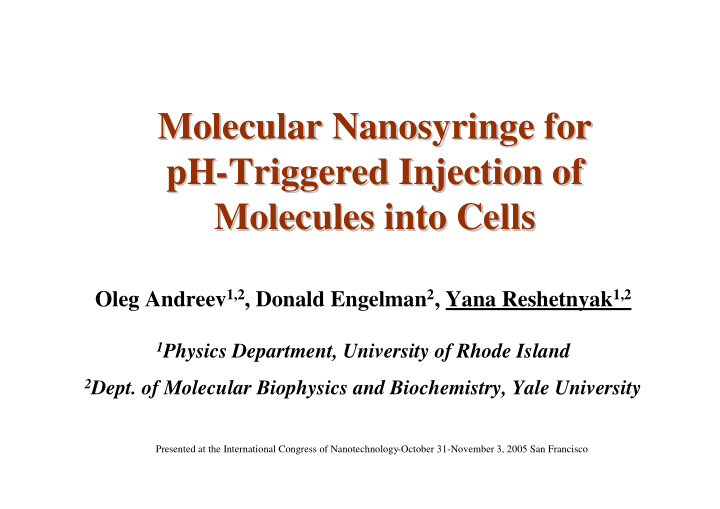



Molecular Nanosyringe Nanosyringe for for Molecular pH- -Triggered Injection of Triggered Injection of pH Molecules into Cells Molecules into Cells Oleg Andreev 1,2 , Donald Engelman 2 , Yana Reshetnyak 1,2 1 Physics Department, University of Rhode Island 2 Dept. of Molecular Biophysics and Biochemistry, Yale University Presented at the International Congress of Nanotechnology-October 31-November 3, 2005 San Francisco
BRC peptide BRC peptide G G E Q N P I Y I Y W W A R Y A D A R Y A D W W L F T T P L L L L D L A L L V L F T T P L L L L D L A L L V D A D E G T D A D E G T G G E Q N P TM Properties of BRC peptide: Properties of BRC peptide: - water-solubility; pH>6.0 pH<6.0 - spontaneous insertion; n - H + - fast insertion (seconds); + H + - reversible insertion; l m - pH-dependent insertion into bilayer in a form of cell membrane transbilayer alpha-helix - Trp fluorescence is sensitive to binding and insertion
The titration of the BRC with The titration of the BRC with liposomes at pH 7.4 and 5.0 liposomes at pH 7.4 and 5.0 The titration was monitored by changes in intensity of tryptophan fluorescence of the BR-C peptide excited at 295 nm 1.0 Fluorescence intensity, a.u. 0.8 0.6 0.4 - pH 7.4 0.2 - pH 5.0 0.0 -200 0 200 400 600 800 1000 1200 1400 1600 Concentration of liposomes (POPC), M
Acidic environment is created in many diseased tissues: cancer heart infarction or stroke atherosclerosis inflammation
What is the energy of binding of binding What is the energy and insertion of the BRC and insertion of the BRC peptide into lipid bilayer bilayer? ? peptide into lipid G - binding G binding -4.5 kcal/mol 4.5 kcal/mol G - insertion G insertion -3 3 kcal/mol kcal/mol
What is the topology of the What is the topology of the BRC peptide insertion? BRC peptide insertion?
Topology of insertion Topology of insertion NO 2 - NBD -2 S 2 O 4 outside Fluorescence, a.u. triton 0 50 100 150 200 250 Time, sec inside POPC triton pH3 pH8 N-terminus Fluorescence, a.u. -2 S 2 O 4 The topology of insertion was evaluated by using the fact that membrane-impermeable -2 ) can chemically modify dithionite ion (S 2 O 4 the NBD fluorophore and quench its fluorescence 0 50 100 150 200 250 Time, sec
N- -terminus of the BRC terminus of the BRC N peptide inserted into peptide inserted into liposomes is outside outside liposomes is
What is the oligomeric state of the What is the oligomeric state of the BRC peptide in solution and BRC peptide in solution and liposomes at neutral and low pHs? liposomes at neutral and low pHs? The BRC peptide in 95% is a The BRC peptide in 95% is a MONOMER in solution on the MONOMER in solution on the surface and inserted into surface and inserted into membrane at concentrations membrane at concentrations <40µ µg/ml g/ml <40
General concept of Molecular Nanosyringe Nanosyringe General concept of Molecular N S-S- pH7.4 pH < 7.0 S-S- - S-S HS- HS- healthy diseased healthy diseased blood blood tissue tissue tissue tissue pH7.4 pH < 7.0 C
The pH dependent insertion of the BRC The pH dependent insertion of the BRC peptide and delivery of the dansyl dansyl dye dye peptide and delivery of the into HeLa HeLa cells cells into pH7.0 The pictures were taken on the two-photon confocal microscope BioRad MRC-1024 with excitation at 740 nm.
Synthesis of the Synthesis of the BRC- -S S- -S S- -phalloidin phalloidin- -TRITC construct TRITC construct BRC TRITC Phalloidin
pH- -Selective translocation of the Selective translocation of the pH FACS analysis FACS analysis Phalloidin- -TRITC by the BRC peptide into TRITC by the BRC peptide into Phalloidin untreated cells human (HeLa HeLa) and mouse prostate ) and mouse prostate human ( (TRAMP- -C1) and breast (JC) cancer cells C1) and breast (JC) cancer cells (TRAMP pH7.4, 37ºC pH6.5, 37ºC pH6.5, 4ºC
The ability to wash out non- -cleavable cleavable The ability to wash out non BRC- -phalloidin phalloidin- -TRITC construct with TRITC construct with BRC buffer at pH 7.4 ruled out the endocytotic endocytotic buffer at pH 7.4 ruled out the pathway of molecules translocation pathway of molecules translocation
Cell toxicity Membrane leakage Cell toxicity Membrane leakage assay assay assay assay Cell toxicity and membrane leakage Cell toxicity and membrane leakage tests ruled out the possibility of tests ruled out the possibility of formations of pores in membrane formations of pores in membrane
Biological effects of the translocated translocated into cells phalloidin into cells phalloidin Biological effects of the The translocation of phalloidin Multinucleation was observed inside the cells led to inhibition of after 48 hours after treatement of cytoskeleton dynamics and loss of cells with BRC-S-S-Phalloidin at ability of cells to contract and pH6.5 for 1 hour followed by a change shape in response to change of the medium to DMEM treatment by EDTA/trypsin dissociation solution.
Whole- -body Fluorescence Imaging body Fluorescence Imaging Whole To study of the distribution of the BRC peptide in mice and it accumulation in tumor by whole-body fluorescence imaging emission filter CCD-Camera lamp lamp computer excitation camera filter controller dark box
Conclusion Conclusion BRC peptide is a first example of novel class of transmembrane peptides for pH-selective delivery and translocation of molecules into cells
Acknowledgement Acknowledgement Oleg Andreev, Physics Department., URI Don Engelman , Department of Molecular Biophysics and Biochemistry, Yale University Srikanth Sandugu Graduate student, Physics Department, URI
Recommend
More recommend